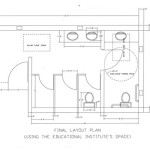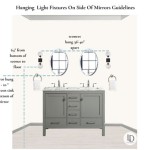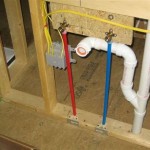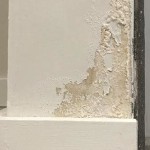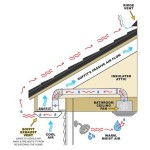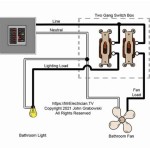Can You Connect Two Bathroom Exhaust Fans To One Vent? Considerations and Best Practices
The question of whether to connect two bathroom exhaust fans to a single vent is a common one, especially in homes with multiple bathrooms situated close together. While seemingly a cost-effective and space-saving solution, the viability and safety of this configuration depend on a number of factors. This article explores the potential benefits, drawbacks, and required safety measures involved in connecting multiple bathroom exhaust fans to a single vent duct.
The primary motivation for connecting two exhaust fans to one vent often revolves around simplifying the ductwork. Running a single duct to the exterior of the house is perceived as easier and less expensive than installing two separate ducts. This approach can also be appealing when space is limited in the attic or other areas where ductwork is routed. However, it's crucial to carefully assess the implications of this decision before proceeding.
The International Residential Code (IRC) and other local building codes provide specific guidelines regarding bathroom ventilation. These codes aim to ensure proper air exchange to prevent moisture buildup, mold growth, and the accumulation of potentially harmful pollutants. Deviating from these established guidelines, even with good intentions, can lead to code violations and compromise the health and safety of the occupants.
Understanding the Potential Problems
Connecting two bathroom exhaust fans to a single vent is not inherently prohibited, but it introduces several potential problems that must be addressed. Chief among these is the potential for backdrafting. Backdrafting occurs when one fan is operating and forces air back through the other fan when it is not operating. This is highly problematic because it renders the inactive fan ineffective and potentially allows moisture and odors to migrate from one bathroom to the other.
Another significant concern is reduced airflow. When two fans are connected to a single duct, the resistance within the duct increases. This resistance can significantly reduce the amount of air each fan is able to exhaust. The effectiveness of both fans is therefore compromised, potentially leading to inadequate ventilation and moisture buildup in both bathrooms.
Furthermore, the sizing of the duct becomes critical. A duct designed for a single fan may be undersized for two fans operating simultaneously. An undersized duct will further exacerbate the airflow issues and potentially damage the fans themselves due to increased motor stress.
Finally, consider the potential for noise transmission. A shared duct can act as a sound conduit, allowing noise from one bathroom to easily travel to the other. This can be particularly disruptive if one bathroom is being used while the other is not.
Necessary Components and Installation Considerations
If, after careful consideration, connecting two exhaust fans to a single vent remains the preferred option, specific components and installation techniques are essential to mitigate the potential problems. The most critical component is a backdraft damper for each fan. A backdraft damper is a one-way valve that allows air to flow out of the fan but prevents air from flowing back in. This effectively isolates each fan from the other, preventing backdrafting and ensuring that air is only exhausted to the outside.
The backdraft dampers should be installed as close as possible to the exhaust fan housing. This minimizes the length of duct where backdrafting can occur. The dampers should be of high quality and designed for quiet operation to minimize noise. Regular inspection and maintenance of the dampers are also necessary to ensure they are functioning correctly.
Duct sizing is another critical factor. The duct must be sized to accommodate the combined airflow of both fans. The airflow of a fan is measured in cubic feet per minute (CFM). To determine the appropriate duct size, add the CFM ratings of both fans. Consult a duct sizing chart or an HVAC professional to determine the correct duct diameter for the combined airflow.
For example, if each fan is rated at 80 CFM, the total CFM is 160. A 4-inch duct is generally adequate for a single 80 CFM fan, but it would likely be undersized for two such fans. A 6-inch duct is typically recommended for 160 CFM, but it's always best to consult a chart or expert to confirm.
Smooth, rigid ductwork is preferable to flexible ductwork. Flexible ductwork introduces more resistance to airflow due to its corrugated interior. If flexible ductwork must be used, it should be kept as short as possible and installed with minimal bends. All duct connections should be sealed with foil tape or mastic to prevent air leaks. Air leaks reduce the efficiency of the ventilation system and can contribute to moisture problems.
The duct should be routed to the exterior of the house through a roof or wall vent. The vent should be equipped with a damper to prevent backdrafting from outside and to keep out pests. The vent should also be positioned to prevent moisture from re-entering the house.
Alternative Solutions and Best Practices
Before proceeding with connecting two exhaust fans to a single vent, it is essential to explore alternative solutions. Running separate ducts for each fan is typically the most effective and reliable way to ensure proper ventilation. While this may require more effort and expense initially, it eliminates the potential problems associated with shared ductwork.
Another option is to upgrade to a single, more powerful exhaust fan. If the CFM requirements of both bathrooms are similar, a single fan with a higher CFM rating could be installed to ventilate both spaces. This approach requires careful consideration of the duct layout and the placement of the fan to ensure adequate ventilation in both bathrooms.
Proper ventilation is crucial for maintaining indoor air quality and preventing moisture problems. When choosing a ventilation system, it is important to consider the size of the bathroom, the frequency of use, and the climate. Over-ventilation can waste energy and cause discomfort, while under-ventilation can lead to moisture buildup and mold growth.
Regular maintenance is also essential for ensuring the continued effectiveness of the ventilation system. This includes cleaning the fan blades, inspecting the ductwork for leaks, and replacing filters as needed. A properly maintained ventilation system will provide years of reliable service and help to protect the health and safety of the occupants.
The decision to connect two bathroom exhaust fans to a single vent should not be taken lightly. Careful consideration of the potential problems, adherence to building codes, and proper installation techniques are essential. Consulting with an HVAC professional is highly recommended to ensure that the ventilation system is safe, effective, and code-compliant.
Ultimately, the best approach is to prioritize proper ventilation and choose the solution that provides the most reliable and efficient way to remove moisture and pollutants from the bathrooms. While connecting two fans to one vent may seem appealing, it is often more prudent to invest in separate ductwork or a single, more powerful fan to ensure optimal performance and long-term satisfaction.
Building codes often address ventilation requirements with specific CFM (cubic feet per minute) requirements based on the size of the bathroom. These codes are designed to ensure adequate air exchange and prevent moisture buildup that can lead to mold growth and structural damage. Always consult local building codes before making any changes to ventilation systems.
It's also important to consider the noise level of the exhaust fans. Fans with lower sone ratings are quieter and less likely to be disruptive. When selecting a fan, look for a model with a low sone rating and a CFM rating that is appropriate for the size of the bathroom. Combining two noisy fans into a single duct could amplify the noise issue, making a quiet alternative even more desirable.
In conclusion, while connecting two bathroom exhaust fans to one vent is technically possible, it demands a thorough understanding of potential pitfalls and the implementation of specific safeguards. A careful evaluation of alternatives, adherence to building codes, and consultation with qualified professionals are crucial for ensuring a safe, effective, and compliant ventilation system.

How To Use An In Line Exhaust Fan Vent Two Bathrooms Diy Family Handyman
Hvac Talk Heating Air Refrigeration Discussion
Hvac Talk Heating Air Refrigeration Discussion
2 Bathroom Fans Connected To 1 Roof Vent Diy Home Improvement Forum
Can I Vent Multiple Bathroom Fans To The Same Hole Using Flexible Duct And Connectors Or Will They Blow Air Into Each Other Instead Of Venting Outside Quora

Bathroom Exhaust Fan Gfci Vent Protection Requirements Checkthishouse

Can Bathroom Exhaust And Dryer Share Same Outside Duct Diy Home Improvement Forum

3 Bathroom Exhaust Fan Venting Options Codes

Bathroom Exhaust Fans Building America Solution Center

What Parts Do I Need To Install An Inline Fan In My Bathroom
Related Posts
